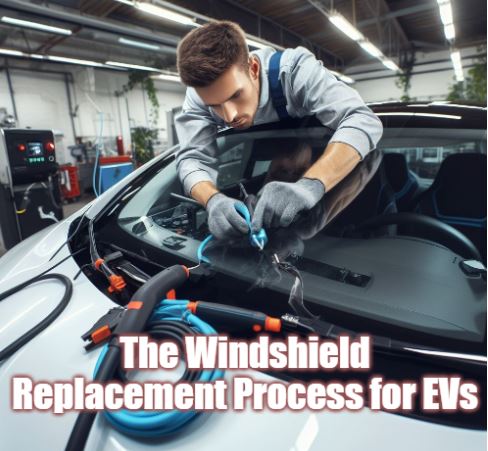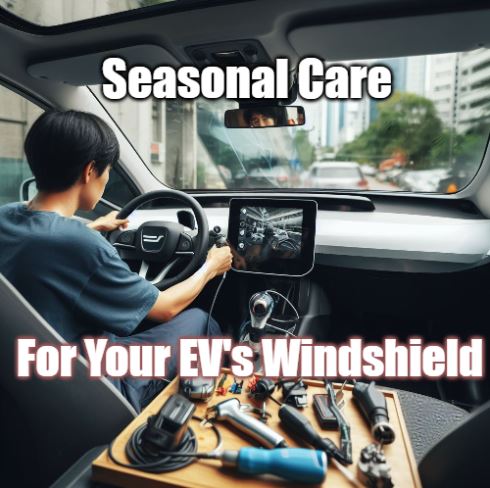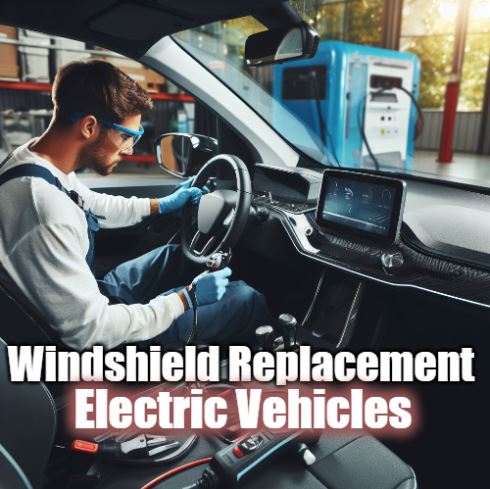When it comes to electric vehicles (EVs), every component plays a crucial role in the overall performance and efficiency. Among these, the windshield is not just a piece of glass that keeps bugs out of your face; it’s an integral part of the vehicle’s structural integrity and functionality. Windshield replacement for electric vehicles is a topic that deserves special attention due to the unique features and requirements of these modern marvels.
Understanding the Importance of Your EV’s Windshield
The windshield of an electric vehicle does more than offer a clear view of the road. It’s also a key player in the aerodynamics and energy efficiency of the vehicle. A well-maintained windshield can help maintain the optimal performance of your EV. Therefore, understanding what you should know about windshield replacement is vital for any EV owner.
The Role of Aerodynamics in EV Windshield Design
Electric vehicles are designed with aerodynamics in mind to extend their range. The windshield is a large part of this design and must be replaced with precision to maintain the original aerodynamic profile.
Advanced Windshield Technologies in EVs
Many electric vehicles come equipped with advanced windshields that include features like infrared coatings or heads-up displays. When replacing your windshield, it’s essential to consider these infrared windshields and how they work, ensuring that you maintain all the functionalities your EV offers.
- Heads-Up Displays (HUD): Projects important information, such as speed and navigation, directly onto the windshield, allowing drivers to keep their eyes on the road.
- Electrochromic Technology: Also known as smart glass, this allows windshields to change their tint automatically to reduce glare and improve visibility and comfort.
- Infrared (IR) Coatings: These coatings help to reflect infrared light, keeping the car cooler in hot weather and reducing the need for air conditioning.
- Acoustic Glass: A special layer in the windshield helps to dampen external noises, providing a quieter cabin experience.
- Gorilla Glass Windshields: Tougher and more damage-resistant than standard glass, Gorilla Glass is used to reduce the risk of chips or cracks.
- Integrated Antennas and Sensors: Windshields that house antennas for radio and GPS, as well as sensors for rain detection, automatic wipers, and ADAS systems.
- Heated Windshields: Fine wires or conductive films embedded within the glass can heat the windshield to quickly defrost or de-ice it.
- Solar Charging Windshields: Some windshields come with integrated solar cells that help charge the car’s battery, extending the vehicle’s range.
- Augmented Reality (AR) Windshields: Future AR windshields could display a wide range of information and interactive features, enhancing the driving experience.
- Windshield Display Zones: Sections of the windshield can display different types of information, such as vehicle status or alerts, without obstructing the driver’s view.
Choosing the Right Windshield: OEM vs. Aftermarket
Selecting the right type of windshield is crucial. OEM (Original Equipment Manufacturer) glass is designed specifically for your vehicle model, which is often recommended for electric vehicles to ensure a perfect fit and maintenance of vehicle integrity. Learn more about the types of windshields: OEM vs. aftermarket to make an informed decision.
The Windshield Replacement Process for EVs

Replacing a windshield on an electric vehicle involves more than just swapping out the glass. It requires careful handling of sensors and calibration of cameras if your EV is equipped with advanced driver-assistance systems (ADAS). For a detailed understanding, consider reading about the windshield replacement process.
1: Pre-Inspection and Preparation
- Assess the Damage: Determine if the windshield can be repaired or needs replacement.
- Prepare the Vehicle: Ensure the EV is powered down and key systems are disengaged.
2: Removal of the Damaged Windshield
- Remove Wipers and Cowling: Take off the windshield wipers and the plastic cowling to access the windshield edges.
- Cut the Adhesive: Use specialized tools to cut the adhesive bead around the windshield without damaging the vehicle’s body.
3: Frame Cleaning and Preparation
- Clean the Frame: Remove any remaining adhesive and debris from the frame where the new windshield will sit.
- Apply Primer: If necessary, apply a primer to the frame to ensure a strong bond with the new adhesive.
4: Calibration of Advanced Driver-Assistance Systems (ADAS)
- Sensor Removal: Carefully remove any sensors attached to the old windshield.
- Sensor Calibration: After the new windshield is installed, recalibrate the sensors to ensure proper functionality of ADAS.
5: Installing the New Windshield
- Apply Adhesive: Apply a new bead of urethane adhesive to the frame or the new windshield, depending on the manufacturer’s recommendations.
- Set the New Windshield: Carefully place the new windshield onto the adhesive, ensuring it’s properly aligned.
6: Reinstallation of Components
- Reattach Components: Reinstall any hardware that was removed, such as mirrors, wipers, and the cowling.
- Seal and Check for Leaks: Ensure the seal is watertight and check for any leaks around the edges.
7: Final Calibration and Testing
- Final Calibration: Perform a final calibration of ADAS, ensuring all systems are fully operational.
- Test Drive: Conduct a test drive to ensure the windshield and all related systems are functioning correctly.
8: Post-Installation Instructions
- Curing Time: Advise the owner of the necessary curing time for the adhesive before the vehicle can be driven safely.
- Care Instructions: Provide the owner with instructions on how to care for the new windshield during the first few days after installation.
The Windshield Replacement Costs
The cost of replacing a windshield on an electric vehicle can vary significantly based on the model, the type of windshield technology it incorporates, and regional labor costs. Here’s a general price range for specific EV models as of my last update in January 2022. Please note that these prices are estimates and can change over time due to advancements in technology, inflation, and other market factors.
Tesla Model S:
- Standard Windshield Replacement: $800 – $1,200
- Windshield with Advanced Features (like acoustic interlayer, IR coating): $1,200 – $2,200
Tesla Model 3:
- Standard Windshield Replacement: $700 – $1,000
- Windshield with Advanced Features: $1,000 – $1,800
Nissan Leaf:
- Standard Windshield Replacement: $500 – $800
- Windshield with Advanced Features: $800 – $1,500
Chevrolet Bolt EV:
- Standard Windshield Replacement: $400 – $700
- Windshield with Advanced Features: $700 – $1,300
BMW i3:
- Standard Windshield Replacement: $600 – $1,000
- Windshield with Advanced Features: $1,000 – $1,800
Audi e-tron:
- Standard Windshield Replacement: $1,000 – $1,500
- Windshield with Advanced Features: $1,500 – $2,500
Ford Mustang Mach-E:
- Standard Windshield Replacement: $600 – $1,100
- Windshield with Advanced Features: $1,100 – $2,000
Volvo XC40 Recharge:
- Standard Windshield Replacement: $700 – $1,200
- Windshield with Advanced Features: $1,200 – $2,000+
Mini Cooper SE Electric:
- Standard Windshield Replacement: $500 – $900
- Windshield with Advanced Features: $900 – $1,500+
Honda Clarity Electric:
- Standard Windshield Replacement: $600 – $1,000
- Windshield with Advanced Features: $1,000 – $1,700+
Fiat 500e:
- Standard Windshield Replacement: $400 – $800
- Windshield with Advanced Features: $800 – $1,400+
Polestar 2:
- Standard Windshield Replacement: $800 – $1,500
- Windshield with Advanced Features: $1,500 – $2,500+
Mitsubishi i-MiEV:
- Standard Windshield Replacement: $350 – $650
- Windshield with Advanced Features: $650 – $1,200+
Smart EQ fortwo:
- Standard Windshield Replacement: $300 – $600
- Windshield with Advanced Features: $600 – $1,100+
Bollinger B1/B2:
- Standard Windshield Replacement: Estimated $700 – $1,300
- Windshield with Advanced Features: Estimated $1,300 – $2,000+
Lordstown Endurance:
- Standard Windshield Replacement: Estimated $700 – $1,400
- Windshield with Advanced Features: Estimated $1,400 – $2,300+
Fisker Ocean:
- Standard Windshield Replacement: Estimated $800 – $1,600
- Windshield with Advanced Features: Estimated $1,600 – $2,800+
Porsche Taycan:
- Standard Windshield Replacement: $1,000 – $1,800
- Windshield with Advanced Features: $1,800 – $3,000+
Mercedes-Benz EQC:
- Standard Windshield Replacement: $800 – $1,400
- Windshield with Advanced Features: $1,400 – $2,500+
Jaguar I-PACE:
- Standard Windshield Replacement: $1,000 – $1,600
- Windshield with Advanced Features: $1,600 – $2,800+
Hyundai Kona Electric:
- Standard Windshield Replacement: $450 – $850
- Windshield with Advanced Features: $850 – $1,600
Kia Niro EV:
- Standard Windshield Replacement: $450 – $850
- Windshield with Advanced Features: $850 – $1,500
Rivian R1T/R1S:
- Standard Windshield Replacement: Estimated $800 – $1,500
- Windshield with Advanced Features: Estimated $1,500 – $2,500+
Lucid Air:
- Standard Windshield Replacement: Estimated $1,200 – $2,000
- Windshield with Advanced Features: Estimated $2,000 – $3,500+
Volkswagen ID.4:
- Standard Windshield Replacement: $600 – $1,200
- Windshield with Advanced Features: $1,200 – $2,000+
Insurance Coverage for Your EV Windshield Replacement
One of the first questions EV owners ask is whether their insurance will cover the cost of windshield replacement. This can vary based on your policy and the reason for replacement. It’s worth exploring how insurance coverage for windshield replacement works.
Seasonal Care for Your EV’s Windshield

Seasonal changes can affect your EV’s windshield. In colder months, for instance, the care you give your windshield can prevent damage and maintain visibility. For tips on maintaining your windshield during the winter, check out winter windshield care.
Spring:
- Pollen and Debris: Spring can bring a lot of pollen and other organic debris that can stick to your windshield. Use a windshield washer fluid with a detergent to help break down this sticky residue.
- Rainy Conditions: Ensure your windshield wipers are in good condition to handle spring showers. Replace them if they are worn out or leaving streaks.
Summer:
- Heat Protection: Extreme heat can put stress on your windshield, especially if there are any small chips or cracks. Park in the shade or use a sunshade to minimize exposure.
- Cleaning: Regularly clean the outside and inside of your windshield to remove any buildup of road grime, insects, or bird droppings that are more prevalent in summer.
Fall:
- Leaves and Sap: Falling leaves can leave sap and other residues on your windshield. Clean your windshield regularly to prevent any etching or staining.
- Early Frosts: Be prepared for early morning frost by having a proper ice scraper and never use hot water to defrost your windshield, as the sudden temperature change can cause it to crack.
Winter:
- Ice and Snow Removal: Use a proper ice scraper and snow brush to remove ice and snow from your windshield. Avoid using metal tools that can scratch the glass.
- Defrosting: Allow your car to warm up gradually with the defroster setting on, which helps to melt ice and snow without causing thermal shock to the glass.
- Wiper Care: Lift your wipers away from the windshield when parked during snowfall to prevent them from freezing to the glass.
Year-Round Tips:
- Regular Inspections: Check your windshield regularly for any chips or cracks. Small chips can often be repaired if caught early before they turn into larger cracks that require full replacement.
- Quality Wiper Blades: Use high-quality wiper blades that are appropriate for the season. Some blades are designed specifically for winter conditions.
- Proper Washer Fluid: Use windshield washer fluid that is rated for the season. Winter formulas typically have a lower freezing point.
- Gentle Cleaning: When cleaning your windshield, use a soft microfiber cloth to avoid scratches and a cleaner that’s safe for automotive glass.
Safety Standards and Precautions During Replacement
Safety should never be compromised during the windshield replacement process. It’s important to adhere to windshield replacement safety standards and take the necessary safety precautions during windshield replacement.
Post-Replacement Care and Maintenance
After your EV’s windshield has been replaced, proper care and maintenance are key to longevity. This includes choosing the right windshield wipers and understanding the curing time for adhesives used during the installation.
Will My Insurance Cover My Windshield Replacement?
This is a common question among EV owners. The answer depends on your insurance policy and the specifics of your coverage. It’s important to ask your provider about insurance coverage for windshield replacement before you need it.
Ensuring the Best for Your Electric Vehicle
Windshield replacement for electric vehicles is not just about maintaining visibility; it’s about preserving the intricate balance between form and function that makes your EV special. By choosing the right service provider, understanding the technologies involved, and knowing what your insurance covers, you can ensure that your electric vehicle continues to operate at its best.
Remember, your windshield is as important as any other high-tech component of your EV. Treat it with care, and it will contribute to your vehicle’s performance, safety, and efficiency for miles to come.
FAQs – Windshield Replacement for Electric Vehicles
Windshield replacement for electric vehicles often involves additional steps due to the integration of advanced technologies like ADAS, heads-up displays, and special sensors. These systems may require careful removal, reinstallation, and recalibration when the windshield is replaced.
No, it’s recommended to wait for the adhesive used to install the new windshield to cure fully. This can take anywhere from a few hours to a day. Your technician will provide a specific wait time based on the materials used.
Windshield replacement is typically not covered under the vehicle’s warranty unless the damage is due to a manufacturing defect. However, it may be covered by your auto insurance policy, depending on the terms and the cause of the damage.
Yes, some electric vehicles use specially designed windshields that may have coatings for UV and IR protection, or are made from stronger, lighter materials to improve efficiency and range.
It is not recommended to replace the windshield of an electric vehicle yourself. The process requires specialized tools and knowledge, especially for vehicles with integrated technology. It’s best to have it done by a professional to ensure safety and functionality.
If the replacement windshield is of the same quality and specifications as the original, there should be no effect on the vehicle’s range. However, using a heavier or less aerodynamic windshield could potentially affect efficiency.
Not all shops may be equipped to handle the specialized needs of electric vehicles, especially those with advanced technologies. It’s important to choose a shop that has experience with electric vehicles and the necessary equipment for proper calibration.
Content reviewed and published by SLP AutoGlass Editorial Team.

